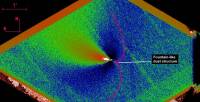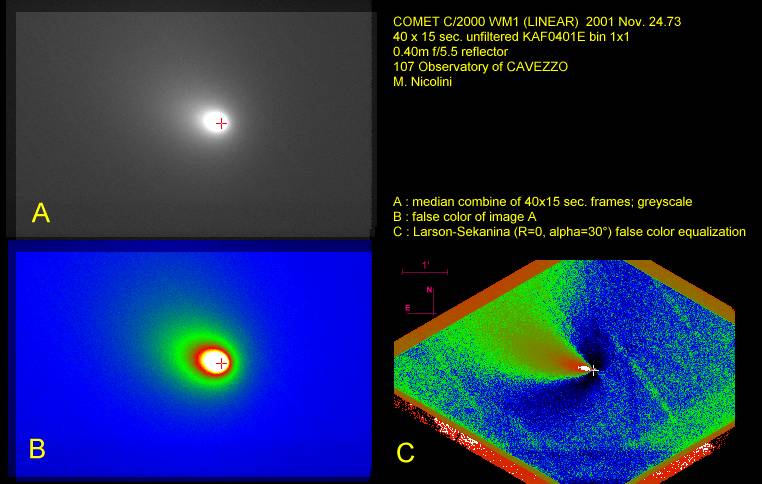 [Full scale of image C] Larson-Sekanina on the median combine of 40x15 sec. frames with outlined fountain structure.
[Full scale of image C] Larson-Sekanina on the median combine of 40x15 sec. frames with outlined fountain structure. 
 [Full scale of image C] Larson-Sekanina on the median combine of 40x15 sec. frames with outlined fountain structure.
[Full scale of image C] Larson-Sekanina on the median combine of 40x15 sec. frames with outlined fountain structure.
|
DATE (UT) yyyy mm day |
MAG. |
ERR. |
INSTR. |
CAMERA |
FILTER |
SINGLE FRAME (sec. of exposure) |
COMBINED FRAME (# of frames x sec. of exposure) |
|
2000 12 28.78241 |
17.6(i) |
- |
A1 |
A1 |
unfiltered |
300 |
- |
|
2000 12 31.78172 |
17.3(i) |
- |
A1 |
A1 |
unfiltered |
- |
|
|
2001 10 11.85385 |
12.8(i) |
- |
A1 |
A2 |
unfiltered |
- |
|
|
2001 10 12.90657 |
12.4(i) |
- |
A1 |
A2 |
unfiltered |
- |
|
|
2001 10 13.90906 |
11.3(i) |
- |
A1 |
A2 |
unfiltered |
- |
|
|
2001 10 14.87878 |
11.0(i) |
- |
A1 |
A2 |
unfiltered |
- |
|
|
2001 10 21.83635 |
10.9(i) |
- |
A1 |
A2 |
unfiltered |
- |
|
|
2001 11 04.87575 |
10.4(i) |
- |
A1 |
A1 |
unfiltered |
||
|
2001 11 14.86530 |
-- |
- |
A1 |
A1 |
unfiltered |
||
|
2001 11 15.94000 |
-- |
- |
A1 |
A1 |
unfiltered |
30 |
- |
|
2001 11 16.92000 |
-- |
- |
A1 |
A1 |
unfiltered |
30 |
- |
|
2001 11 24.73097 |
-- |
- |
A1 |
A1 |
unfiltered |
MAG.: the estimated magnitude of the coma taking a reference standard diameter of 100.000 kilometers. It could be simply instrumental (i), derivated with this procedure and with a zero point derivated with reference stars usually from USNO 2.0 or GSC 1.1 catalogues, or in standard photometric bands like (V) or (I).
ERR.: the estimated error of the magnitude.
INSTR.: the telescope used for acquiring the frame(s). A1: reflector 0.4m f/5.5 of Cavezzo, direct focus; A2: reflector 0.4m f/5.5 of Cavezzo, focus Newton; B1: Yaeger refractor 0.15m f/11 of Cavezzo; C1: tele 500mm. f/5.6; D1: tele 135mm. f/2
CAMERA: the CCD camera used for the exposures. A1: Audine with KAF0401E binning 1x1; A2: Audine with KAF0401E binning 2x2; B1: Starlight Express HX516 with Sony ICX084AL HyperHAD binning 1x1; B2: Starlight Express HX516 with Sony ICX084AL HyperHAD binning 2x2.
FILTER: the filter used for imaging.
SINGLE FRAME: seconds of exposure is a link with the A.F.A. preview of the original FITS frame from which the magnitude was estimated. The frame is corrected with a master Dark Frame and a master Flat Field, astrometrically and photometrically calibrated with Astroart. The FITS header contains all the data useful for analysis and WCS keywords for an immediate reading of the objects positions. You can download the FITS frame from the A.F.A. preview page and use AVIS to visualize the image and read the astrometric informations stored in the header.
COMBINED FRAME: sum or average of a number of frames x seconds of exposures are the link with the A.F.A. preview of the original FITS image arised from an averaged or summed combine of multiple frames acquired during the same imaging session. These images are usually used for image processing (like the application of the Larson-Sekanina algorithm) and other morphological studies of the comet.
![[2001-11-24] Larson-Sekanina](wm1-24nov-mini.jpg) [2001-11-24] Larson-Sekanina on the median combine of 40x15 sec. frames. Click here for a full scale frame (0.8"/pixel) of image C with fountain structures outlined. Good seeing (about 3").
[2001-11-24] Larson-Sekanina on the median combine of 40x15 sec. frames. Click here for a full scale frame (0.8"/pixel) of image C with fountain structures outlined. Good seeing (about 3").
![[2001-11-16] Larson-Sekanina](wm1-16nov-mini.jpg) [2001-11-16] Larson-Sekanina on the median combine of 20x30 sec. frames.
[2001-11-16] Larson-Sekanina on the median combine of 20x30 sec. frames.
![[2001-11-15] Larson-Sekanina](wm1-15nov-mini.jpg) [2001-11-15] Larson-Sekanina on the sum of 20x30 sec. frames. Poor seeing
[2001-11-15] Larson-Sekanina on the sum of 20x30 sec. frames. Poor seeing
![[2001-11-14] Larson-Sekanina](wm1-14nov-mini.jpg) [2001-11-14] Larson-Sekanina on the average of 10x30 sec. frames. Bad weather conditions and very poor seeing
[2001-11-14] Larson-Sekanina on the average of 10x30 sec. frames. Bad weather conditions and very poor seeing